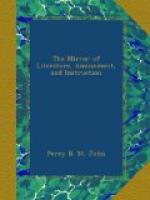Another portion of the same infusion of galls had solution of isinglass added to it until it no longer produced a precipitate; by employing the sulphate of iron, a black compound was produced, which, although paler than that formed from the entire fluid, appeared to be a perfect and durable ink. Lastly, a portion of the infusion of galls was kept for some time at the boiling temperature, by means of which a part of its contents became insoluble; this was removed by filtration, when, by the addition of the sulphate of iron, a very perfect and durable ink was produced. In the above three processes I conceive that a considerable part of the mucilage, the tan, and the extract, were respectively removed from the infusion, while the greater part of the gallic acid would be left in solution.
The three causes of deterioration in ink, the moulding, the precipitation of the black matter, and the loss of colour, as they are distinct operations, so we may presume that they depend on the operation of different proximate principles. It is probable that the moulding more particularly depends on the mucilage; and the precipitation on the extract, from the property which extractive matter possesses of forming insoluble compounds with metallic oxides. As to the operation of the tan, from its affinity for metallic salts, we may conjecture, that, in the first instance, it forms a triple compound with the gallic acid and the iron; and that, in consequence of the decomposition of the tan, this compound is afterwards destroyed. Owing to the difficulty, if not impossibility, of entirely depriving the infusion of galls of any one of its ingredients, without, in some degree, affecting the others, I was not able to obtain any results which can be regarded as decisive; but the general result of my experiments favours the above opinion, and leads me to conclude, that, in proportion as ink consists merely of the gallate of iron, it is less liable to decomposition, or to experience any kind of change.
The experiments to which I have alluded above, consisted in forming a standard infusion by macerating the powder of galls in five times its weight in water, and comparing this with other infusions, which had either been suffered to mould, from which the tan had been extracted by gelatine, or which had been kept for some time at the boiling temperature; and by adding to each of these respectively, both the recent solution of the sulphate of iron, and a solution of it, which had been exposed for some time to the atmosphere. The nature of the black compound produced was examined by putting portions of it into cylindrical jars, and observing the changes which they experienced with respect either to the formation of mould, the deposition of their contents, or any change of colour. The fluids were also compared by dropping portions of them upon white tissue paper, in which way both their colour and their consistence might be minutely ascertained. A third method was, to add together the respective infusions, and the solutions of the sulphate of iron, in a very diluted state, by which I was enabled to form a more correct comparison of the quantity, and of the state of the colouring matter, and of the degree of its solubility.




